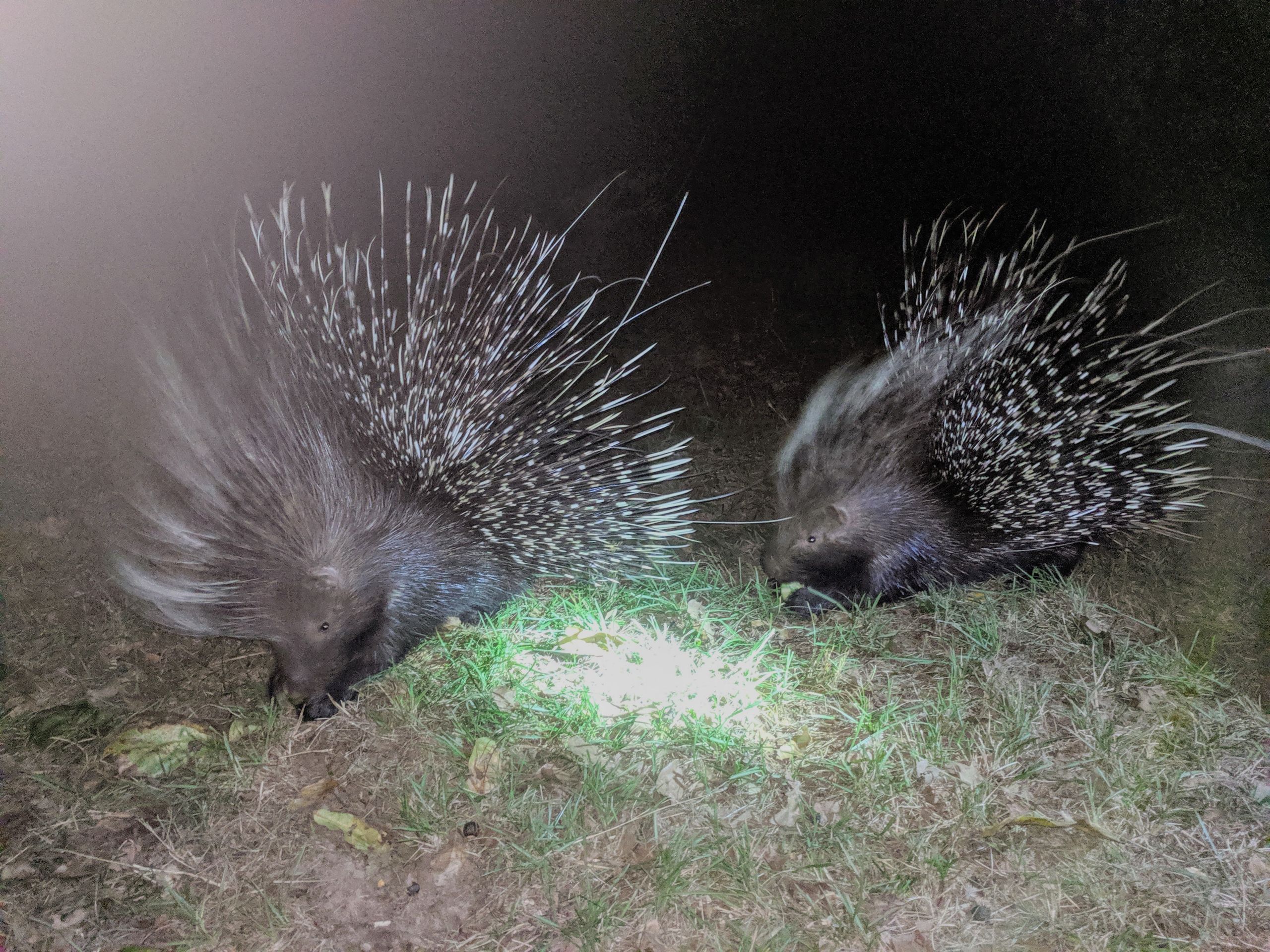
African Crested Porcupines hystrix cristata
The African Crested Porcupine, also known as a crested porcupine, is one of the world’s largest rodents. They are common in sub-Saharan Africa, but can be found as far away as northern Africa and Italy. Like other rodents, crested porcupines are nocturnal, and monogamous. Small family groups consisting of a male, female, and their young will live in a complex system of burrows. They are most active at night, leaving their den to forage alone before returning to their group.

Alligator El lagarto mississippiensis
Native habitat: Primarily freshwater swamps and marshes, but also in rivers, lakes and smaller bodies of water in the southeastern United States: Alabama, Arkansas, North & South Carolina, Florida, Georgia, Louisiana, Mississippi, Oklahoma, and Texas. Alligator is derived from the Spanish el lagarto which means "The Lizard".
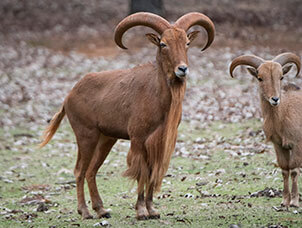
Aoudad Ammotragus lervia
Native habitat: Barbary sheep are found in arid mountainous areas where they graze and browse grasses, bushes, and lichens. This sheep is becoming difficult to find in its native North Africa. The aoudad is classified as a vulnerable species. Fortunately, populations in Spain and the southern United States are flourishing. Aoudads are exceptionally sure-footed. They can clear a 6 foot obstacle with ease from a standing start.
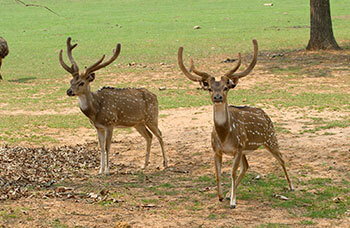
Axis Deer Cervus axix
Also called the Indian Deer, Spotted Deer, and the Chital Deer. Native habitat: The lowlands plains and lower hills, where they can be found grazing among bushes, trees, or bamboo forest. Native to India. Introduced in to Texas in 1932.
.jpg)
Barasingha Cervus duvauceli
Also called Swamp Deer. Native habitat: Dry and wet swampy grasslands of India. This deer is an endangered species surviving only in national parks of India, zoos, and wildlife parks.

Bison Bison bison athabascae
Bison are the largest mammal in North America, Male Bison can weigh up to 2,000 pounds and stand 6 feet tall. Yellowstone National Park is the only place in the U.S. where bison have continuously lived since prehistoric times.
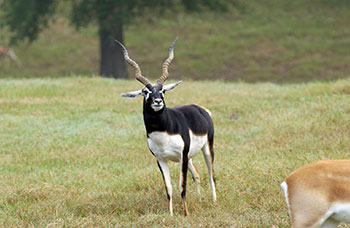
Blackbuck Antilope cervicapra
Native habitat: Dry woodland and clearings in India and eastern Pakistan. They have been hunted to near extinction in India. Fortunately, herds have been introduced in Texas and Argentina with great success.
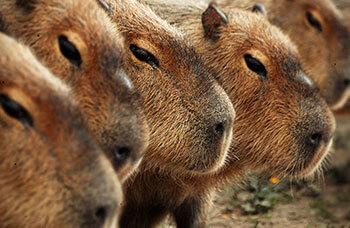
Capybara Hydrochaeris hydrochaeris
Native habitat: This semi-aquatic rodent lives in Central and South America in swamps, marshes and forests near ponds, lakes and rivers. Capybaras are the biggest rodent in the world followed by the beaver and porcupine. Its closest relatives are guinea pigs. Adult Capybara can grow to 80 – 150 pounds. Capybaras are herbivores, grazing mainly on grasses and aquatic plants, fruits and tree bark.
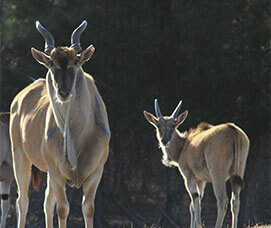
Common Eland Taurotragus oryx
Native habitat: Found in eastern, central and southern Africa. Prefer plains or moderately rolling country with brush and scattered trees, sub-desert, savanna, woodlands, grasslands, and mountaintops up to 15,000 ft. Even-though Common Eland are greatly reduced in number, they are not considered endangered.

Dromedary Camel Camelus Dromedarius
Native habitat: Deserts in northern Africa, Arabia, and the Middle East, while a feral population is found in Australia. Every member of the Camelus Dromedarius species is either domesticated or has become feral.

Emu Dromaius novaehollandiae
Native habitat: Emus are found throughout Australia from woods to scrubland to grassland to desert areas, but not in Rainforests. The Emu is a flightless bird.
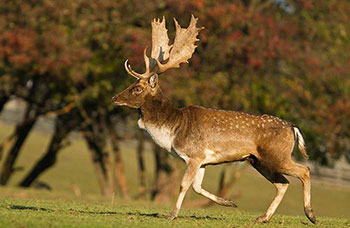
Fallow Deer Dama dama
Native habitat: Deciduous and mixed woodland of Iran and Iraq. Fallow deer are the most widely kept of the world's deer. They have been introduced to all inhabited continents. The Texas population is approximately 15,000.
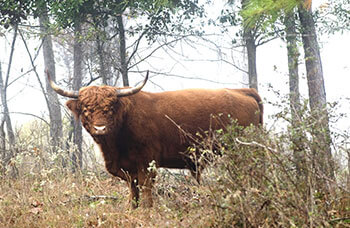
Highland Cattle Bovidae Bos Taurus
The Highland breed has lived for centuries in the rugged remote Scottish Highlands. The extremely harsh conditions created a process of natural selection, where only the fittest and most adaptable animals survived to carry on the breed. Today, Highlands are found throughout North America, Europe, Australia, and South America. Despite long horns and an unusual appearance, Highlands are even-tempered, bulls as well as cows. They can be halter trained as easily as any other breed.
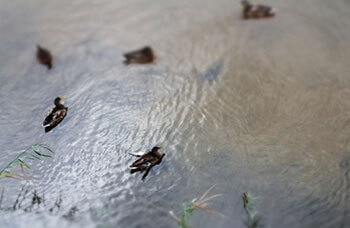
Khaki Campbell
Great Britain. An early 20th Century Breed, designed to be with chickens, a splasher rather than a swimmer.
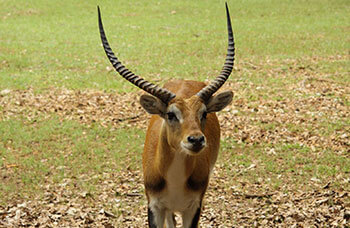
Lechwe Kobus leche
Native habitat: Floodplains bordering swamps and marches in Zambia and Botswana in Africa. This small marsh antelope was placed under threat in 1978 when a hydroelectric plant was built that reduced populations by 50%. Now, Lechwe are classified as a low risk, but remain conservation dependent.

Llama Lama glama
Native habitat: Llamas are found all over the world, but the species are native to South America, mostly Bolivia, Chile and Peru, with a few in Argentina and Ecuador. Llamas are one of the oldest domesticated animals. They have been used for pack animals for almost 4000 years. Llamas are members of the camel family.
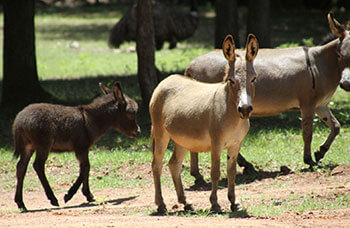
Miniature Donkey Equidae Equus Asinus
Miniature Donkeys are native to the Mediterranean islands of Sicily and Sardinia, where they are almost extinct. Miniature Donkeys have not been bred down in size. When originally imported into the U.S., they were between the sizes of 32" and 38". They have laid-back, easy-going personalities and form close attachments to their owners and to other donkeys. Donkeys communicate by "braying," more commonly known as a hee-haw. Males are Jacks and females are Jennet.
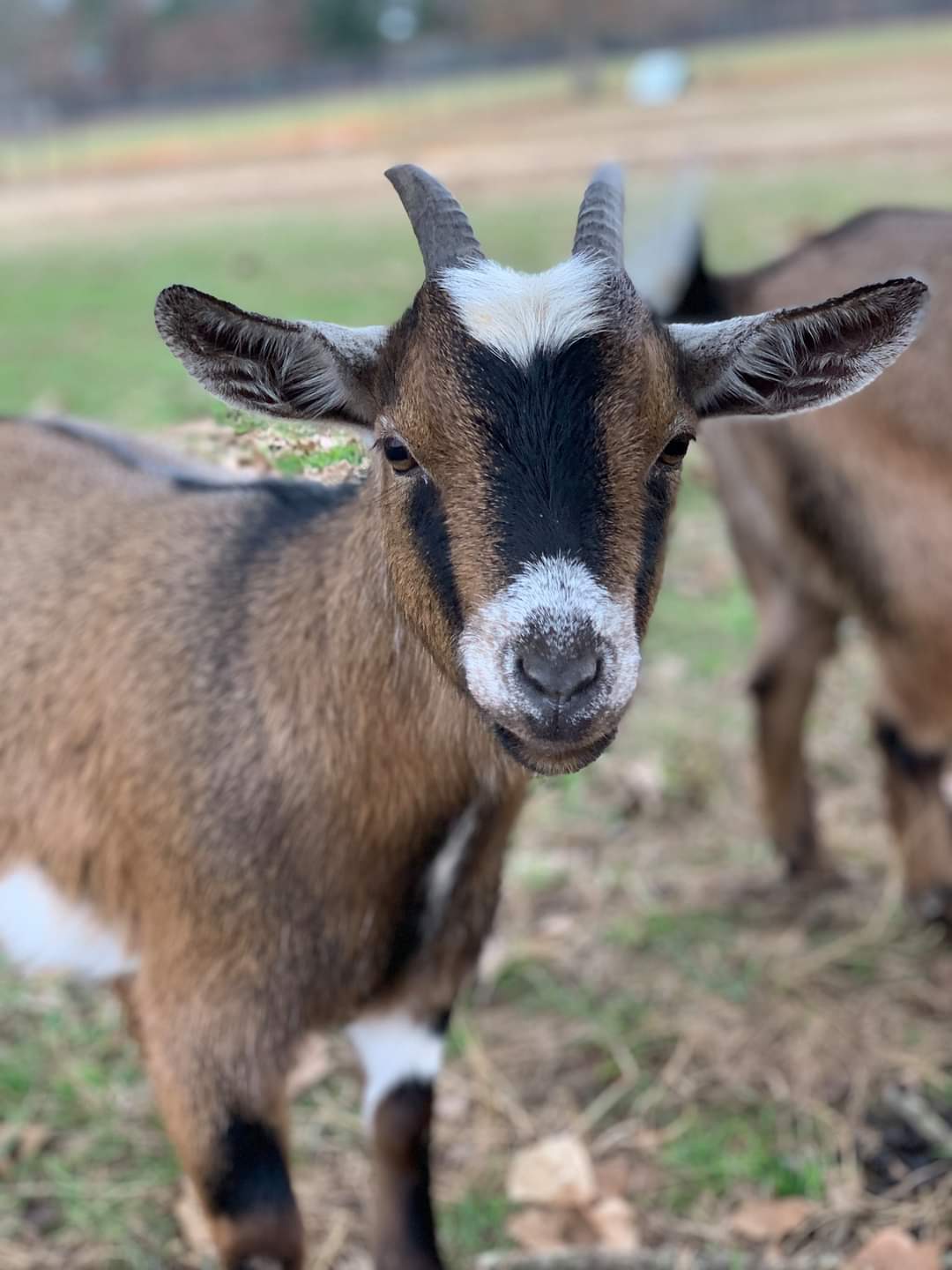
Nigerian Dwarf Goat Capra aegagrus hircus
The Nigerian Dwarf Goat is a miniature goat of West African origin. They are similar in appearance to larger dairy goats but ideally, do not stand taller than 17 to 19 inches. The coat can vary considerably by color and pattern. Ideal weight is about 75 pounds. Nigerian Dwarf Goats were first introduced to the United States in the early 20th century.
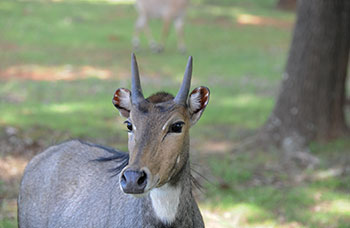
Nilgai Boselaphus tragocamelus
Native habitat: Grassy plains and woodlands throughout India. The nilgai is classified as a low risk, conservation dependent species. The short coat is yellow-brown in females, and gradually turns blue-grey in males as they mature.
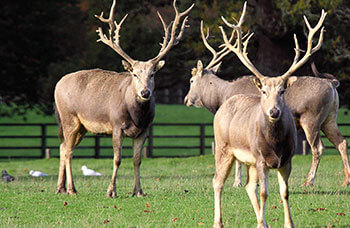
Pere David Deer Elaphurus davidianus
These animals were first made known to Western science in the 19th century, by Father Armand David, a French missionary working in China. At the time, the only surviving herd was in a preserve belonging to the Chinese emperor. Its original habitat is thought to have been swampy, reed-covered marshlands. It is a grazer, eating mainly grass which it supplements with water plants in the summer. A recent count put the population at 2,500 individuals in three Chinese national nature reserves and smaller parks.
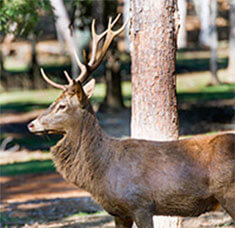
Red Deer Cervus elaphus
Native habitat: The red deer inhabits most of Europe, parts of Asia and northwestern Africa. It is the only species of deer to inhabit Africa. Red deer have been introduced to other areas, including Australia, New Zealand and Argentina. The red deer is one of the largest deer species. The slightly larger American elk or wapiti is an entirely different species. Conservation efforts, especially in the United Kingdom, have resulted increased red deer populations. In North Africa, the population continues to decline.
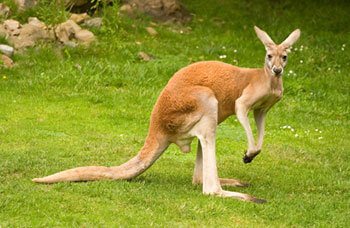
Red Kangaroo Macropus Rufus
The Kangaroo is a common marsupial from the islands of Australia and New Guinea. There are 47 species of "roos." Kangaroos can hop up to 40 miles per hour (74 kph) and go over 30 feet (9 m) in one hop. An adult male is called a buck, boomer or jack, and an adult female is called a doe, flyer, roo, or jill. A baby is called a joey. A group of roos is called a mob. Kangaroos are herbivores (plant-eaters) eating grass, leaves, and roots. They swallow their food without chewing it and later regurgitate a cud, which they then chew. Roos need little water. They can go for months without drinking.
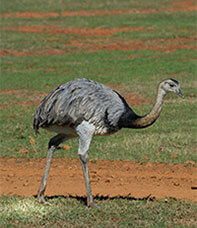
Rhea Rhea americana
Native habitat: The greater rhea roam the open pampas and sparse woodlands of Argentina and Brazil. It is the largest of all South American birds standing about 4 feet tall and is related to ostriches and emus. Rheas are flightless birds using their long, powerful legs to outrun trouble. Their large wings are used for balance and for changing direction as the bird runs. Females lay their eggs in a ground nest built by the male. Several females deposit their eggs in the same nest, which may hold 50 eggs or more. The male rhea incubates the eggs for six weeks and cares for the newly hatched young. They aggressively guard their young during this period and will charge any animal—even a female rhea—that approaches too closely.
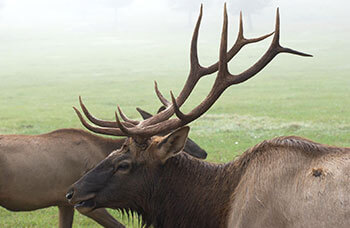
Rocky Mountain Elk Cervus elaphus nelsoni
Native habitat: Ranges from New Mexico to north central British Columbia. They prefer high elevations in semi-open forests and mountain meadows near cover in summer. In winter, Elk migrate to lower sheltered valleys, winds swept meadows, and lower wood slopes.
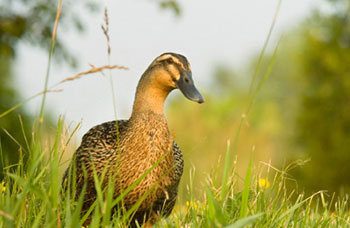
Rouen
Named for the city in France where they originated. Appearance is very much like the Mallard.
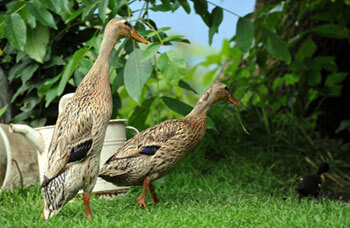
Running Ducks
Developed in Scotland from stock that originated in the East Indies.
Ducks prefer wetlands with large amounts of floating, emergent, and submerged vegetation. Wetlands also produce a great deal of aquatic invertebrates on which ducks feed.
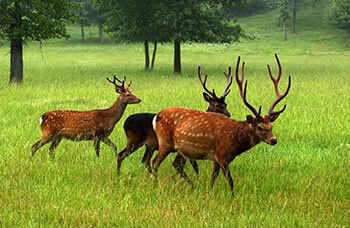
Sika Cervas Nippon
Native habitat: Variable habitats, including forests, marshes and grasslands in Eastern Asia and Japan. The sika is regarded as sacred in Japan. Sika is Japanese for a small deer. Cervus (Latin) a stag, deer Nippon (Japanese) Japan. While many subspecies are in danger, the species as a whole is thriving, with numerous introduced populations in the British Isles, New Zealand, and the United States.
.jpg)
Turkey Meleagris gallopavo
Native habitat: Woods in parts of North America. Turkeys are the largest game birds found in this part of the world. Turkeys eat mostly plant material, including fruits, acorns and other nuts, small grains, and the seeds, shoots and roots of grasses and various other plants. European explorers took Wild Turkeys to Europe from Mexico in the early 1500s. The Turkeys at Chereokee Trace are the Standard Bronze variety.
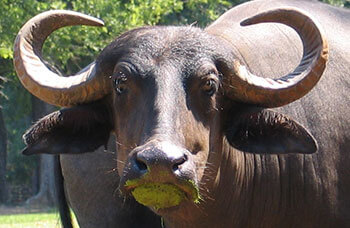
Water Buffalo
The water buffalo is a large ungulate (hoofed animal) and a member of the bovine subfamily. There are two general types of water buffalo. The Swamp (Bubalus carabanesis)which are found from the Philippines to as far west as India, and River (Bubalus bubalis), which are found farther west from India to Egypt and Europe.
The water buffalo has been associated with man from the earliest prehistoric times. Although the water buffalo was originally an Asian animal, it arrived early (about 600 A.D.) in the Near East and North Africa. It was introduced to Europe by crusaders returning in the Middle Ages.
.jpg)
Watusi Bos Taurus
Alternate name Ankole-Watusi. Native habitat: Africa. These regal animals trace their ancestry back more than 6,000 years. They have been referred to as "cattle of kings." It was adopted a breed standard in 1989 to encourage animal scientists to take this unusual breed seriously, instead of treating it as a curiosity.
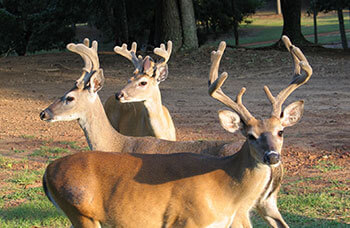
Whitetail Deer Odocoleus virginianus texana
Native habitat: The state of Texas boasts more Whitetail Deer than any other state in North America. The subspecies, Odocoleus virginianus texana, occurs throughout the state. Half of the population resides in the Edwards Plateau region. The population density in this "deer capital" is about one deer per 113 acres.
.jpg)
Wildebeest Connochaetes taurinus
Also called the gnu, the Wildebeest is an antelope of the genus Connochaetes. It is a hooved mammal. It looks like a mixture of features between a cow and a horse. Connochaetes includes two species, both native to Africa: the Black Wildebeest and the Blue Wildebeest. Gnus belong to the family Bovidae, which includes antelopes, cattle and goats. They inhabit the plains and open woodlands of Africa, especially the Serengeti. Wildebeest can live more than 20 years.

Yak Bos grunniens
Native habitat: The Royal Tibetan Yak is found throughout the Himalayan region of south Central Asia, as far north as Mongolia and Russia. Most yaks are domesticated. There is also a small, vulnerable population of wild yaks. Yaks are long-haired bovid with a dense coat, high and humped shoulders and a broad, drooping head. In spite of their bulky, awkward appearance, yaks are excellent, sure-footed climbers. Yak vocalizations are a loud “grunt” - hence the specific name grunniens.

Zebra Equus Burchelli Bohmi
Members of the horse family, Zebras are native to Africa. The Grant’s Zebra is a subspecies of the Plains Zebra. This species survives in abundance in southern and eastern Africa. Grant’s Zebras are white with black stripes on the forequarters which become more horizontal near at the rear of the animal. Zebra stipes serve as camouflage in tall grass to help protect the animal from preditors, such as lions. They may play a role in social interactions within the herd since each has its own unique pattern.
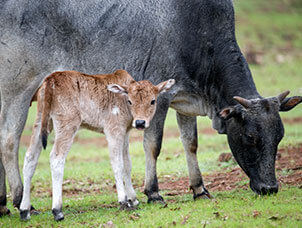
Zebu Primigenius indicus
Native habitat: Miniature zebu originated in Sri Lanka and have adapted to tropical and sub-tropical conditions. They are a very old breed of cattle; possibly dating as far back as 3000 B.C. Miniature zebus are naturally small. They have not been “bred down” to create a smaller size. Miniature zebus are also known as Nadudana zebu. The name “zebu” comes from a Tibetan word meaning “hump.” They are about 42 inches at the withers and weigh between 400 to 600 pounds. Zebu cattle resemble Brahman cattle in appearance, except zebus have smaller, more erect ears rather than droopy.
